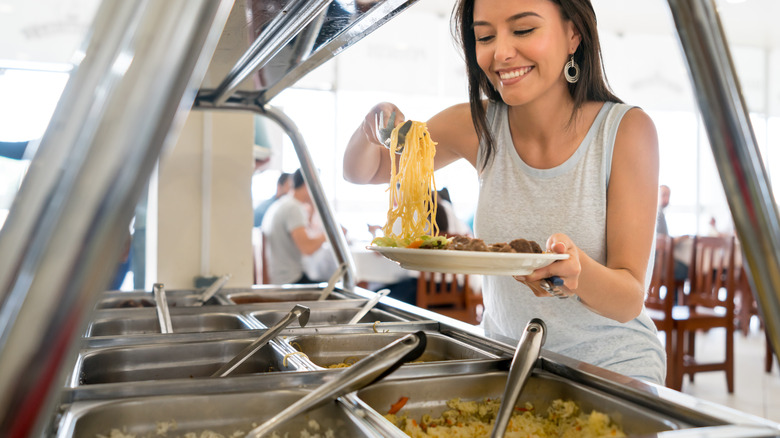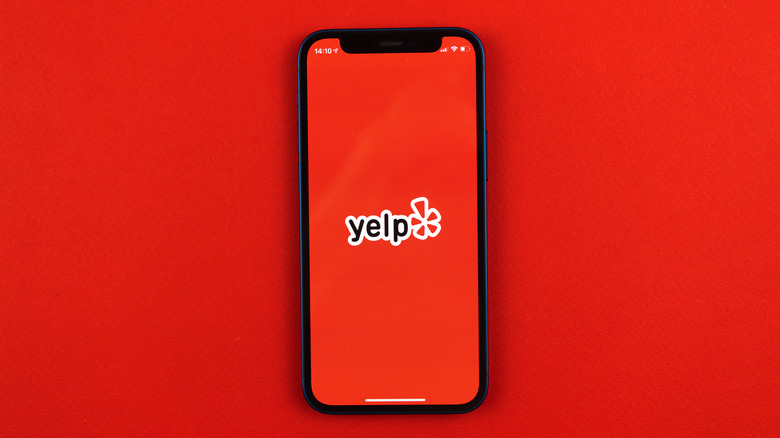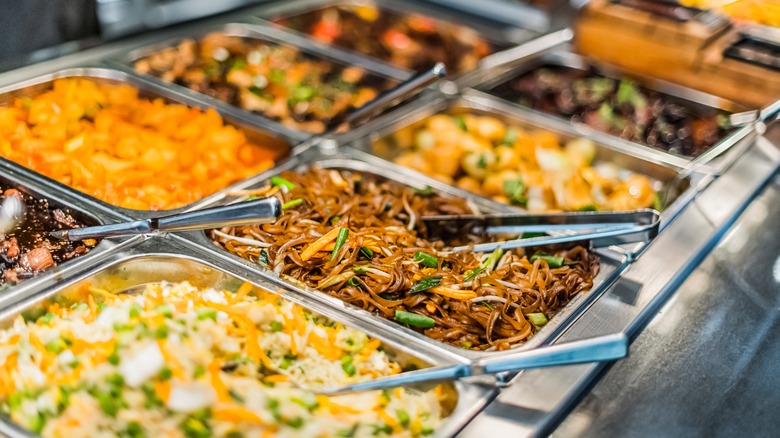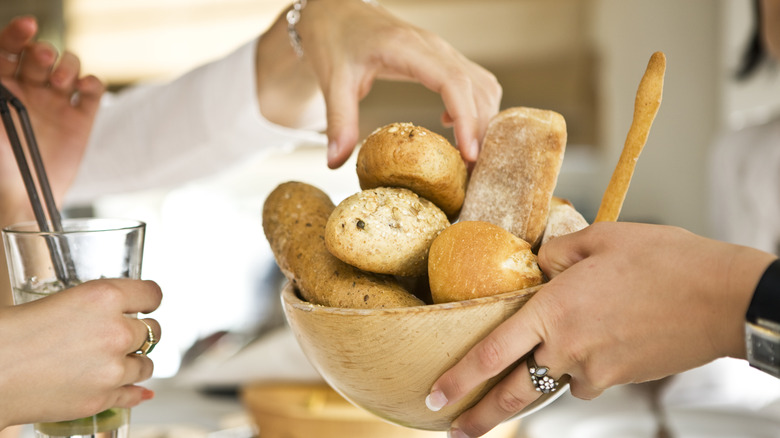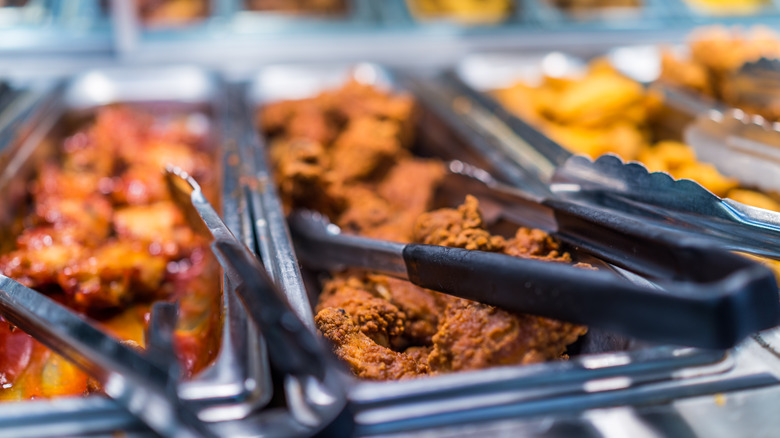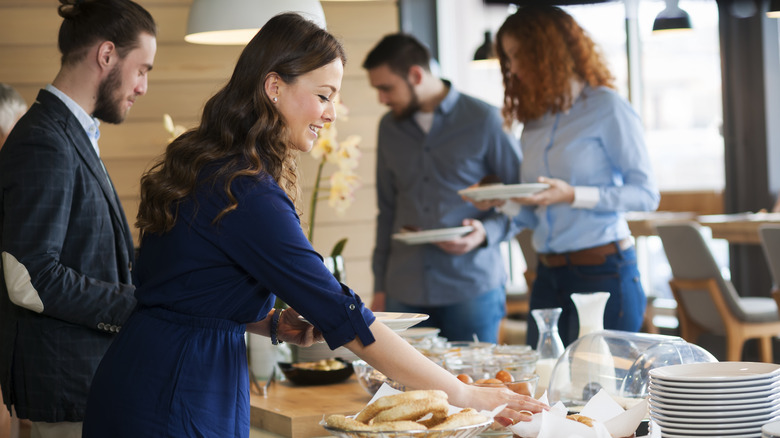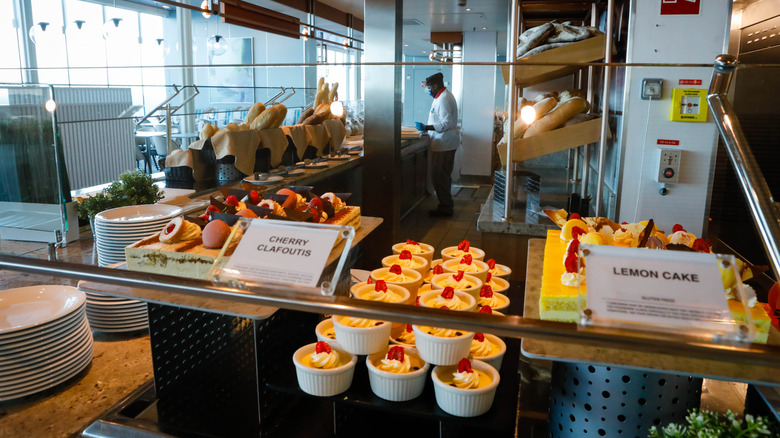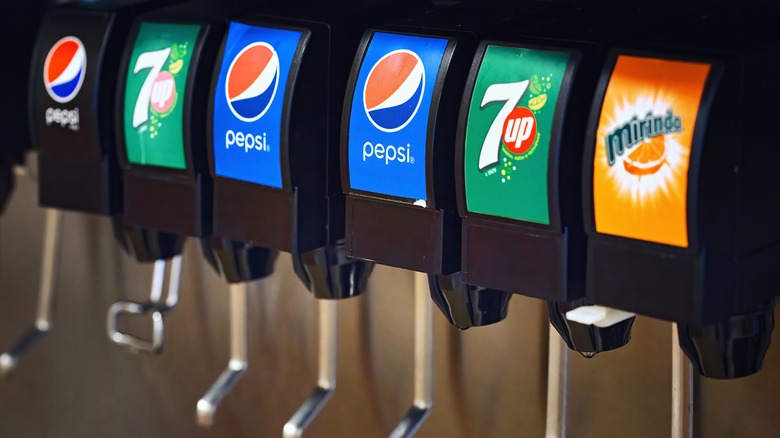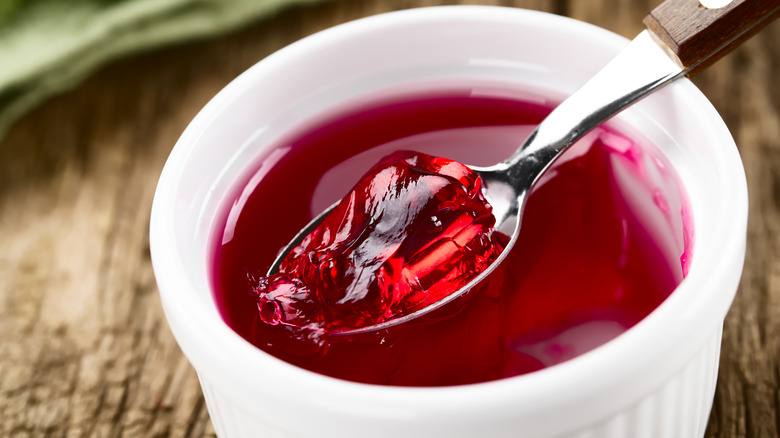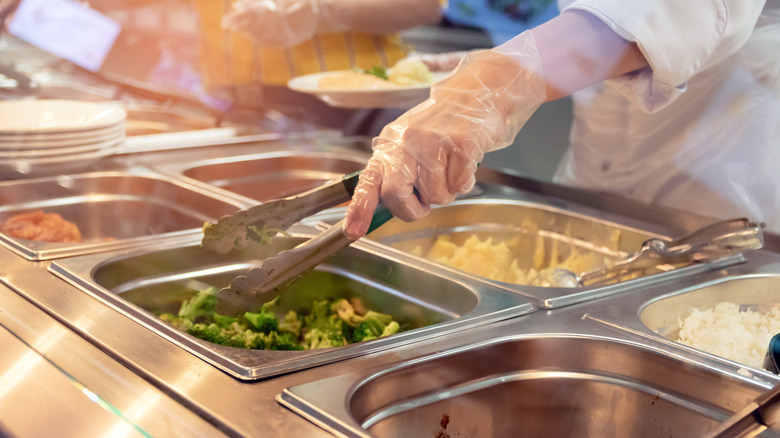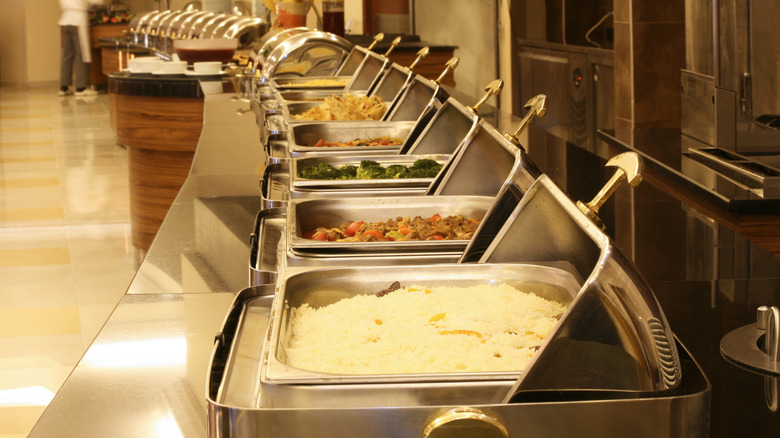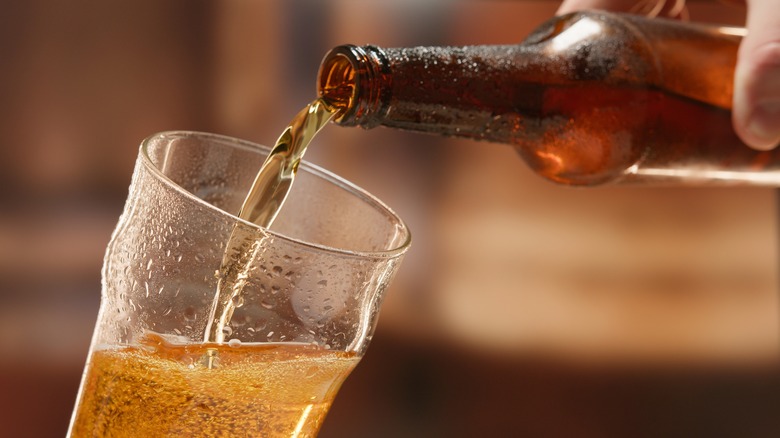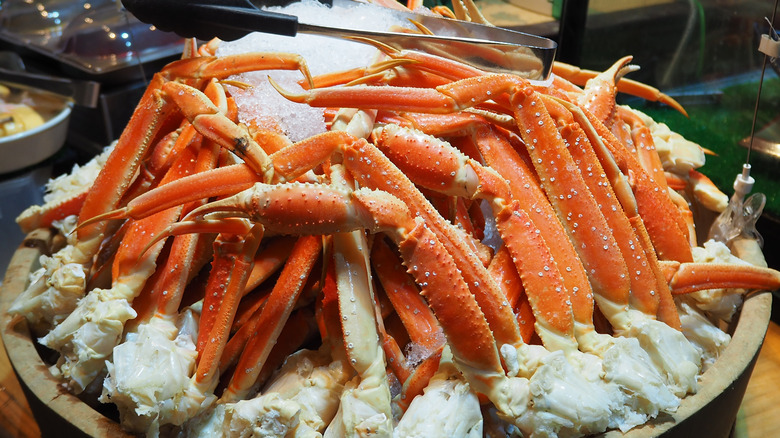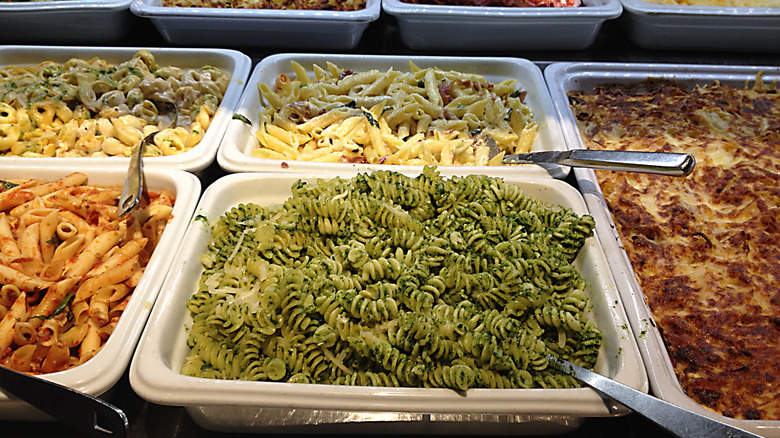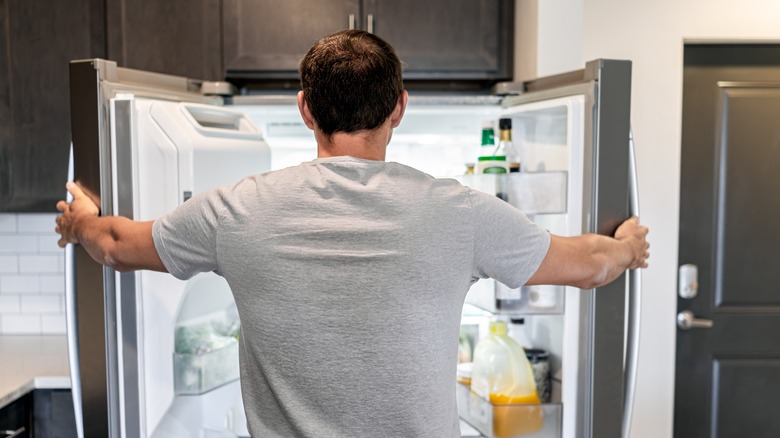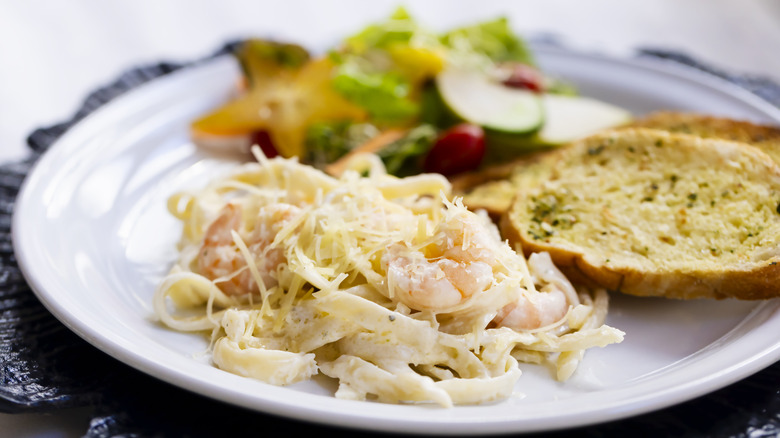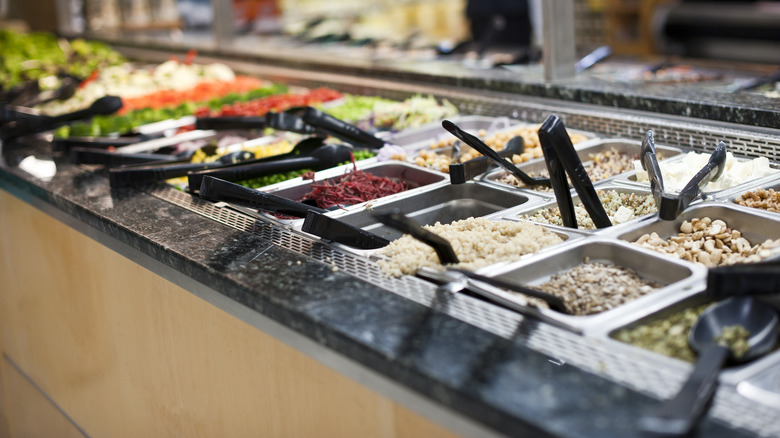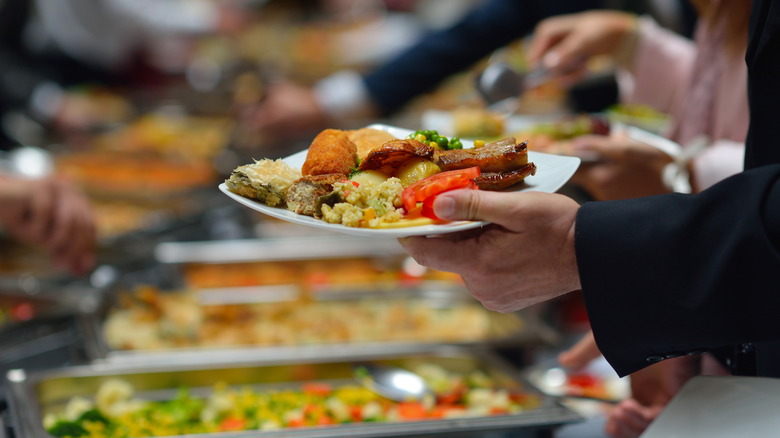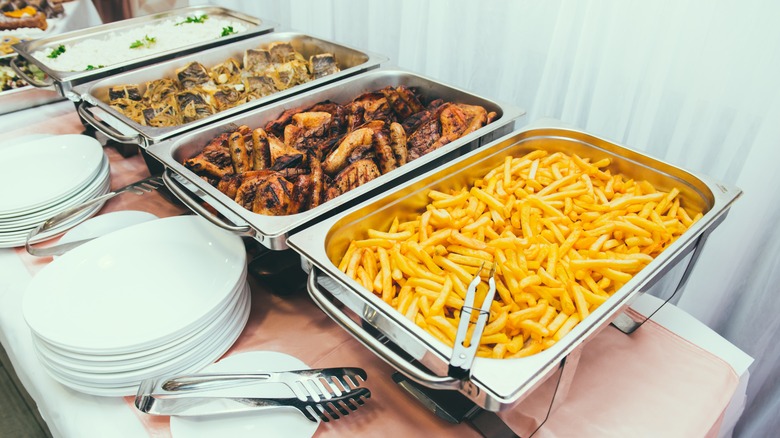20 Tips You Need To Navigate Any Buffet
While you might not be the first person in line at a Golden Corral any time soon, you must appreciate the mechanics, ingenuity, and design of buffet-style dining. Give people free will and a dinner plate, and see what happens.
Buffet dining is often assumed to be a purely American invention, but the concept is actually rooted in nobility and communal celebrations since the dawn of time. Art has depicted the wealthy and the divine consuming copious amounts of bread, butter, meats, and fine wines to celebrate events and victories. But the modern American idea of a buffet didn't emerge until the 1940s in — you guessed it — Las Vegas. Herb McDonald opened the Buckaroo Buffet in "Sin City" to keep patrons in the casinos for longer, keeping the money in the slot machines and gaming tables. Not only was this model successful, but it was replicated across the country in hotels, vacation resorts, business ventures, and almost anywhere you could find a strip mall.
Although the cultural value of buffets may be on the decline (we can thank the 2008 recession and rise of "fast casual" food for that one), there are still people that venture into all-you-can-eat territory. Here are the most important things you must know before eating at any buffet.
Do research to find clean, highly-rated buffets
We've all been guilty of Googling something to death. But with buffets, you should be comfortable researching and doing some digital sleuthing to your heart's content. If you are looking for a new local buffet joint, turn to your Yelp app or Facebook search bar to see what people say about that establishment. Are people commenting that the buffet is clean with good service? Or are they saying the food is lackluster and the salad bar looks a little questionable?
We recommend triangulating your sources if you're looking for the absolute best buffets to eat from. Don't let one bad Yelp review deter you from eating at a buffet; instead, craft a whole picture of the restaurant using several different search engines and sources.
Pick a buffet with varied cuisines or one that best suits your palate
The first question you should ask when choosing a buffet is: "What am I in the mood to eat?" For example, if you're not a fan of eating Chinese food, we recommend not going to a Chinese buffet. But if you're more open to eating foods from various ethnic origins, we recommend going to a buffet with diverse food options — like hotels or casinos.
The best way to determine what kind of food a buffet offers is to do some research before you go. For example, you might find some sample menus online or a list of daily specials indicating what kind of food you might have to choose from. Granted, you likely won't get a complete list, but you will have a better idea when you sit down in the comfy booth.
Avoid getting the food at the front of the buffet
Buffets are strategically designed so that customers eat more of the cheap stuff and less of the expensive stuff. This is why buffets tend to put cheap, starchy foods like bread toward the front of the buffet line.
One study published in Plos One indicates that the order in which buffet diners see certain foods lined up impacts what they choose to take first. Three-quarters of the diners studied chose the first food they saw in the buffet line, while the first three foods in the line made up 66% of all the foods that were selected. Therefore, if you want to make the most of your buffet experience, try not to pick the first foods you see at the buffet.
Always use separate tongs for each tray
The threat of cross-contamination is real at a buffet. One of the red flags at a buffet that should make you turn around is seeing shared serving utensils for multiple trays of food. While sharing a utensil is harmless for some types of foods, it can be both unsafe and just plain gross for others. For example, using the same utensil can share bacteria from foods like raw sushi to ready-to-eat meats. Moreover, folks with allergies can be more at risk if they come into contact with utensils that have been contaminated with a potential allergen.
We should also note that there are serving utensils for a reason — this isn't the time to use your fingers. And if you accidentally drop the serving spoon on the ground, alert a staff member that a new one is needed.
Take a walk around before getting any food
If you're ordering from a regular restaurant, do you just blindly pick the first food that comes to mind, or do you read and study the menu for what foods sound the most appetizing? At a buffet, you typically don't have a menu to go off of. So instead, you'll want to take a quick walk around the buffet lines to see what foods pique your interest once you finally grab a plate.
Taking a walk around the line is the easiest way to see (and use your other senses) to find the best options at the buffet. This time will also give you a chance to look for any potential red flags and foods to avoid. Once you've adequately surveyed your options, start filling your plate.
Save the starches for the end of the meal
Buffets typically offer a range of foods to satisfy many palates and restaurants save themselves a few extra bucks doing so. Buffets rely on people filling up on starches, like pasta, bread, and rice, more than eating expensive items. So, in order to encourage diners to eat starches, eateries may place these items toward the front of the buffet, use larger serving spoons, or offer larger plates near the starches.
But if you know about this buffet hack beforehand, you can plan around it. We recommend filling up your pasta and other starches toward the end of your meal. This will allow you to sample the different options before loading your dish with mac and cheese.
Save room for dessert
There's more to the buffet than just savory options. Most buffets will carry a range of dessert choices, including pastries, cakes, cookies, and ice cream, to satisfy everyone's sweet tooth. We recommend saving a little bit of room in your buffet experience to sample these desserts.
The logic of the buffet design also carries over into desserts. You'll likely find the cakes cut into slivers so thin that you can see through them and individually scooped crème brulées in tiny ramekins. Meanwhile, there's no limit to the self-serve soft-serve machine. If you want to hack this part of the buffet, try to sample a bit of every dessert before returning for seconds. We also recommend avoiding the pudding; these recipes may call for lightly-cooked eggs that can spread potential pathogens if improperly made or stored on the buffet line.
Skip the fizzy drinks and opt for water instead
What is the best drink option to get from the buffet? Not only is it free, but it will also help you maximize how much food you can eat. You should opt for water at the buffet rather than sugar-ladened sodas and fizzy drinks for more than just health reasons.
Soda is one of the things you should never get from a buffet because it can cause you to crave more carbohydrate-rich and cheap foods from the buffet line. In addition, research from the University of Southern California notes that the sucrose in soda can also interfere with satiety hormones — which can cause you to eat so much that you get uncomfortably full (which has pros and cons in the context of a buffet).
Eat less of the foods you can make at home
Eating out should be a novel experience — so why would you get foods that you could eat at home? Instead, use buffets to explore cuisine you can't otherwise make in your kitchen. Snow crab, elegantly plated desserts, and prime rib are some of the foods that you may devour during your next trip to your buffet — all of which are worth trying. If you're tasting new foods for the first time, we recommend sticking with small portions first and then returning for more.
That's not to say that you can't eat pasta with marinara sauce and Kraft macaroni and cheese from the kids' section. We just recommend taking smaller portions if you genuinely want to get the best out of your buffet experience.
Be aware of what other customers are taking and touching
Watching what other people take from the food line at a buffet indicates what dishes are the most popular among diners. For example, if you notice there's a tray of mashed potatoes that two out of the 50 people in line have chosen, there may be a reason why.
Doing an inventory of what food people are picking may also give you an indication of how sanitary your buffet is. Are people pulling down their face masks to smell the food? Did a kid wipe his boogers all over the soft serve machine? Did someone just try to pick up three egg rolls with their fingers — which may or may not have been washed? Keep an eye out on the buffet line and note which foods to avoid.
Choose foods that are served in small pans and refilled often
Running a buffet can be a busy business. A buffet may utilize larger pans to combat staffing shortages during a high-service period. Unfortunately, this means that your food is sitting out under the heat lamp for longer — and potentially won't be as fresh. Not only do many foods lessen in quality over time, but sitting out at room temperature may also risk the potential for foodborne illnesses.
Staff having to refill the pans on the buffet line constantly is an indication that the food you're being served is fresh and that there is high demand for those items. Aim for foods that are served in smaller pans and seem to have a lot of activity around them.
Order an alcoholic beverage to help get you hungry
Cheers to the buffet! Ordering an alcoholic beverage is the buffet hack that will help you get your money's worth out of your experience. According to a study published in Nature, the hypothalamus and its AgRP neurons in the brain are aroused when exposed to alcohol, which in turn causes the body to feel hungry. This means that your body is more predisposed to over-eating after you throw back a few beers.
In addition, alcohol can also increase the neurotransmitter called norepinephrine — which is responsible for feelings of arousal, impulsivity, and excitement. In turn, the activity of this neurotransmitter can cause you not to think twice about grabbing that extra plate of crab legs or slice of cake.
Eat more of the expensive foods
We shouldn't have to tell you this one twice. Knowing which foods on the buffet line are the most expensive is an easy way to increase the monetary value of your buffet experience. Some of the costliest items at a buffet include proteins. Prime rib, which often comes with its own carving station to control portions, should be at the top of your list for must-stops. Fresh seafood (think oysters, clams, and scallops) and sushi are also expensive options at your local buffet. Chocolate fountains are also relatively expensive options for buffet management, making them worth your time as a customer.
In the same breath, you should also avoid the foods that restaurants use as big money-makers — like processed mozzarella sticks that can be easily reheated in an oven, cheap pasta, and starchy potatoes.
Go at lunch-time for a cheaper meal
One of the easiest ways to save money at a buffet is to go at lunchtime instead of dinnertime. Restaurants often set lower prices for lower-volume lunch periods to encourage diners to stop in and eat. So while you may get a relatively paired-down selection of food options (including less labor-intensive stations like the prime rib), you will save some money.
If you prioritize food variety in your buffet experience, you should also consider going on the weekend instead of a weekday. Many buffets offer weekend specials and dishes you won't find during the week. Moreover, a search on a couponing app like Groupon may help yield some discounts like a free kids' buffet meal with the purchase of an adult buffet meal that's a lot more cost-effective.
Don't starve yourself before going to the buffet
One of the biggest mistakes people make when going to a buffet is skipping meals earlier in the day. Fasting before you arrive at the buffet will cause your stomach to shrink, thus preventing how much food you can eat when it comes time to sit down. Eating a small, light meal earlier in the day is best to help you prepare for your buffet experience. Drinking plenty of water throughout the day will also help you stretch out your stomach and will help you eat more food.
Another tool to help you eat more at the buffet is to do some moderate exercise during the day — but not right before eating. A study published in the Journal of Endocrinology indicates that ghrelin, the hunger hormone, is suppressed during exercise but will return after the body has rested and reached its baseline. In other words, don't go from the gym right to the buffet.
Take small portions of food
The best thing about a buffet is that you can try many different types of food from a single restaurant. So, use your buffet experience to explore all the different types of cuisine offered. We recommend getting separate plates for hot and cold food and starting with small servings from each station. Not only does this open your tastebuds to a food that you may not have otherwise tried, but it will also prevent you from taking two scoops too many of macaroni and cheese — just to find out that it has an off-putting taste to it.
If you don't like to have foods touch one another (which we totally understand), you can utilize salad bowls to help separate the portions on your plate.
Be wary of foods that may make you sick
We can't omit the pertinent food safety risks of eating at a buffet. For example, you should steer clear of the salad bar at a buffet because the bacteria that the cooking process would have otherwise killed off may be alive and well on your spinach and lettuce. Cantaloupe, which is a common find with other fruits on the salad bar, may be contaminated with Salmonella bacteria more readily than different types of fruit — and since you can't watch the kitchen staff wash, cut, and store the fruit correctly, you might never know if there is an imminent risk of foodborne illnesses.
Under the same guise, you should be mindful of fish at a buffet. You won't know if the proper sourcing, storage, and refrigeration procedures were taken to ensure that the raw fish on your plate is safe to eat.
Understand that the buffet's choice in utensils is purposeful
Did you ever notice that the plates at your buffet look slightly different than those at a normal restaurant? Rarely will you see full-size plates and soup bowls on the buffet line. Instead, many buffets use smaller plate sizes to encourage diners to take less food on the line; commercial dishware manufacturers offer "buffet lines" of plate sizes to keep up with restaurant demand. In addition, restaurants often provide customers with large beverages to fill them up cheaply. Soft drinks cost very little because the restaurants just purchase the syrup and supply the carbonated water themselves for a considerable markup.
Another odd thing you may notice about buffets is that servers rarely replenish silverware. This is likely to indirectly discourage folks from going back for more. Instead, restaurants (most notably Asian buffets) offer chopsticks readily because these utensils slow the rate of eating — meaning that you will have more time to think about how full you are.
Skip the fried foods
Fried foods are comfort foods, so they're popular at almost every buffet you'll visit. But you may want to think twice before stacking on the plate of fries and chicken tenders. These foods are relatively easy and inexpensive to purchase, fry in cheap oil or reheat in the oven, and serve to hungry patrons. Not only are these options very filling, but the oil they're fried in won't make you feel great afterward. So maybe saving the nuggets for the youngest buffet patrons isn't a bad idea.
If you're going for a fried food bonanza, you will want to go to the buffet at the start of the service. This means your fries won't sit under the heat lamp, ladened with grease, for longer than they should.
Go to a buffet relatively close to when it first opens
When is the best time to go to a buffet? If you visit a 24/7 buffet in Las Vegas, that's a negligible question.
The best time to go to a buffet is relatively soon after it has opened, but not as soon as the staff unlocks the front door. During the first bit of service, the staff may still be setting the food into trays, organizing the restaurant, and preparing for patrons. As a result, you may not get all the food options you want. But, if you decide to visit the food establishment long after it has opened its doors, your food could be sitting under heat lamps too long to be enjoyable. We recommend aiming for no later than an hour after service has commenced.
Static Media owns and operates Tasting Table and Mashed.
